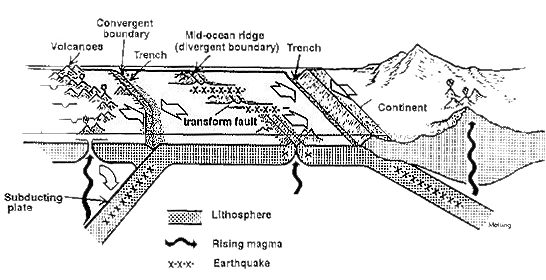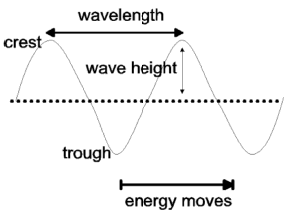BACKGROUND:
Earthquakes and volcanoes are related. Earthquakes can
occur without volcanoes, but volcanoes cannot occur without earthquakes.
Volcanic activity triggers earthquakes. The ground shakes as magma moves
upwards within the crust. Both of these events always create stress within
rocks

Earthquakes can occur without volcanic activity,
because stress can be applied to the Earth’s plates in other ways. For
example, at converging plate boundaries, the force of the two plates coming
together causes many earthquakes. All large, devastating earthquakes are
associated with plate boundary stresses.
The diagram of plate movements shows the
correspondence between earthquakes and rising magma, as well as earthquakes
caused by plate motion alone. Note that the moving plates cause both
earthquakes and volcanoes in the first place. Many small earthquakes also
occur within the volcanoes on the map; they are too small to be shown.
In
the Pre Lab exercise, students will explore how seismic energy travels
through the Earth, and learn that the resulting shaking feels different in
different locations.
Earthquakes are caused by the sudden movement and
fracturing of rock masses along preexisting faults. A fault is a broken
surface within the Earth’s crust. The point on the fault at which the
displacement begins is called the focus of the earthquake. The point on the
surface of the earth directly above the focus is the epicenter.
Energy is produced when an earthquake occurs. This
energy is released in the form of seismic waves. These waves travel
throughout the entire Earth. Waves transmit energy between different points.
There are many kinds of waves, seismic waves are a type of physical wave.
Waves have several parts, as shown in the picture below. In the picture, the
dotted line represents the undisturbed surface, and the wave is moving left
to right. The crest is the high point of a wave. The trough is the low
point. The wavelength is the distance between adjacent crests (or troughs).
The wave height is the vertical distance from the undisturbed surface to the
wave crest. In general, the bigger the waves, the more energy they carry.
Larger waves will be steeper, i.e., have a different shape, than smaller,
less energetic waves of the same wavelength. If wavelength stays the same,
but the energy increases, wave height increases as well.

The energy released during an earthquake causes the
ground to shake. If you are close to the epicenter of an earthquake, the
shaking is more severe than if you were farther away. This change occurs for
many reasons. Most important, seismic energy dissipates as it travels
through rocks, due to friction and other effects. In addition, the different
types of seismic waves travel at different speeds. This means that close to
the epicenter of an earthquake, all the waves arrive at about the same time,
and the ground shakes very hard for a short period of time. Further from the
epicenter, the fastest waves arrive ahead of the slower waves. This
spreading out of energy makes the shaking is less intense.
The seismic waves generated by an earthquake can be
recorded and measured on a seismograph. The record produced by a seismograph
is called a seismogram.
PROCEDURE:
- Explain how earthquakes and volcanoes are interrelated.
- Explain how seismic waves are created. Explain how waves travel
through the Earth. Draw the picture above on the parts of the wave on
the board. Explain how wave shape changes as wave energy changes. Make
sure the students understand that the greater the height of a wave, the
more intense the wave is. You may wish to ask the students the following
questions:
What happens with more energy? Bigger waves are formed.
Will the intensity of shaking increase? Yes.
Will the shape of the waves change? Yes.
What happens with less energy? The wave height decreases.
- Explain that scientists use machines called seismographs to measure
seismic waves. Tell the class that these machines produce charts called
seismograms, that show the frequency and magnitude of the energy waves
produced by earthquakes. Show them the seismogram in the presentation
below. Current seismograms for the United States are available at the U.
S. Geological Survey website
- On a map of the United States, show the class the location of San
Francisco.
- Have the students complete the worksheet. The students should realize
that the energy from a single earthquake can feel different at different
locations.
Answers: 1. five;
2.for an overall understanding of how an earthquake effects a regional area;
3.C and F; 4. A and E; 5. A 16.6, B 18.1, C 11.3, D 16.2, E 22.3, F 18.3